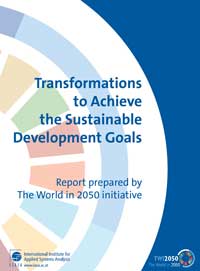| Jul 10, 2018 | |
Six transformations needed to achieve the UN Sustainable Development Goals |
|
| (Nanowerk News) The transformations presented in the report, Transformations to Achieve the Sustainable Development Goals, launched today at the UN High Level Political Forum in New York, US, encompass all the major drivers of societal change, including human capacity, consumption and production, decarbonization, and the digital revolution. They provide a way to achieve the SDGs in a manageable way. | |
 The 17 SDGs, adopted in 2015 by all nations following extensive consultation, offer specific, often quantified objectives for human development to be achieved by 2030. The agenda integrates wide-ranging and aspirational goals for inclusive social and economic development, within global environmental targets for oceans, freshwater, biodiversity, and climate. The World in 2050 (TWI2050) is a global multi-year, multi-stakeholder, interdisciplinary research initiative designed to provide a science-based, integrative approach to address all 17 SDGs. The new report brings together the work of more than 60 authors from 20 organizations involved in the initiative, including coordinating authors from IIASA, Stockholm Resilience Center (SRC), the Sustainable Development Solutions Network (SDSN), the German Development Institute (DIE), Potsdam Institute for Climate Impact Research (PIK), Arizona State University (ASU), and the Netherlands Environmental Assessment Agency (PBL). “The TWI2050 report explores six transformations and pathways that take a comprehensive approach to attaining the 17 SDGs, with a view to ensuring a prosperous and healthy future for all on a resilient and healthy planet. The emphasis is on synergies and multiple benefits that render the SDGs achievable,” says IIASA Deputy Director General Nebojsa Nakicenovic. |
|
| The six key transformations: - | |
| 1. Substantial advances in human capacity are needed through further improvements of education and healthcare – resulting, among others, in higher income and better environmental decisions. | |
| 2. Responsible consumption and production cut across several of the other transitions, allowing us to do more with less – adopting a circular economy approach and reducing demand is important. | |
| 3. It is possible to decarbonize the energy system around 2050 while providing clean and affordable energy for all – including through energy efficiency, more renewables and electrification. | |
| 4. Achieving access to nutritional food and clean water for all, while protecting the biosphere and the oceans requires more efficient and sustainable food systems – for example by increasing agricultural productivity and reducing meat consumption. | |
| 5. Transforming our cities will benefit the majority of the world population – such as through ‘smart’ infrastructure, decent housing and high connectivity. | |
| 6. Science, technology, and innovations are a powerful driver but the direction of change needs to support sustainable development – for example the way in which the world puts the information technology revolution to use. | |
| One of the novel and defining features of the TWI2050 report is that it links integrated assessment modeling, with social science concepts to better reflect societal dynamics in the six transformations. After all, it is humans, and therefore society, who will make the economic, political, technological and cultural choices that determine the outcomes. | |
| As it stands, the world is not on course to achieve the SDGs. Some 3 billion people do not have access to modern cooking and sanitation. A billion people go home hungry and do not have access to electricity. These are the people who are often the most vulnerable to the negative consequences of global industrial development, ranging from climate change to biodiversity loss. A transformation towards a more sustainable future that leaves no one behind needs immediate ambitious action. The TWI2050 report shows that this transformation is possible with strong political commitment. | |
| “It is my hope that this report will provide policy- and decision-makers around the world, with invaluable new knowledge to inform action and commitment towards achieving SDGs and thereby resolving the 21st Century’s greatest challenges. Key elements include investments in capable public institutions, active civil societies, sustainability-oriented alliances, science, engineers, the private sector and governments, and the formulation of action plans and roadmaps to achieve the SDGs,” says Nakicenovic. |
| Source: International Institute for Applied Systems Analysis (IIASA) |
